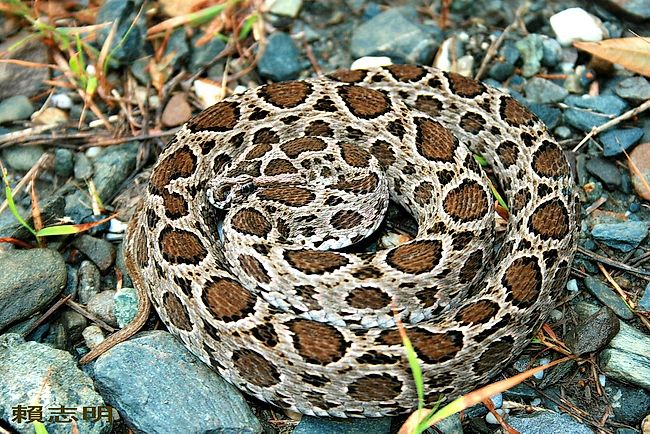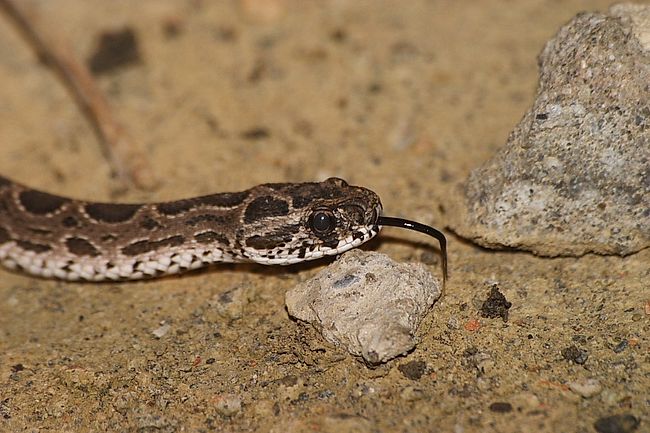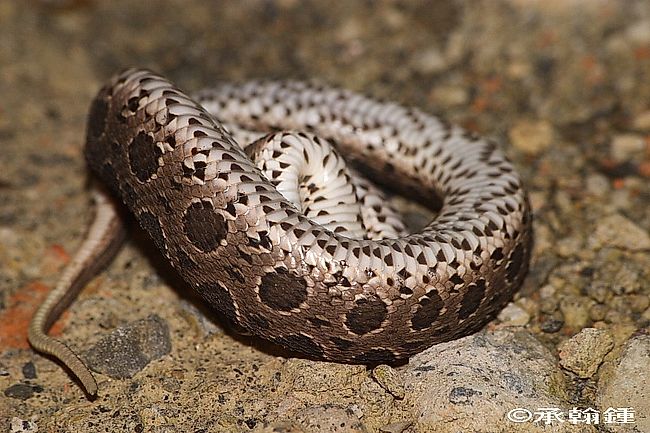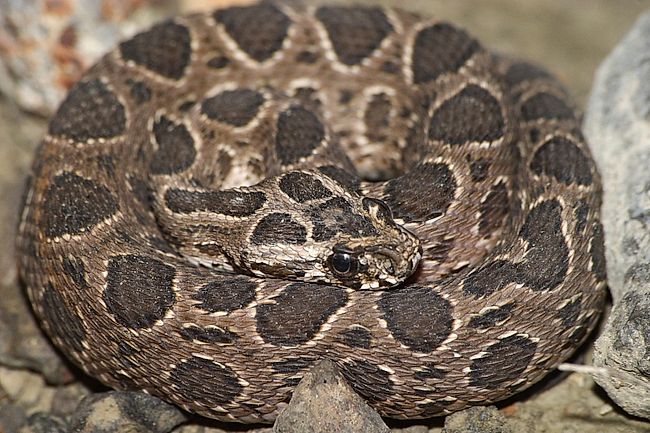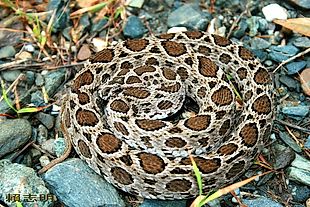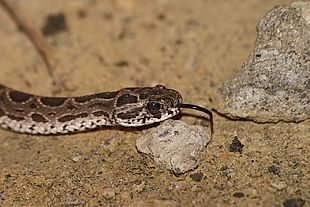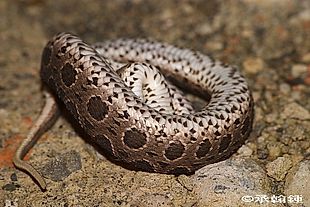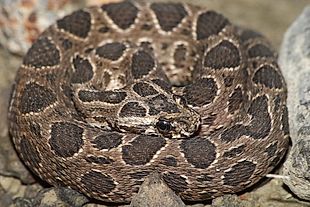Daboia russelli siamensis
Russell's Viper
鎖 蛇 (suo3she2)
Status: Protected (Cat.III)
HIGHLY VENOMOUS!
Videos
- D.russelli in the wild
- 50 D.russelli hatchlings
Family
Colubridae, subfamily Viperinae (True vipers)
Max. length
128 cm
Occurrence in Taiwan
Localized areas of southern and south-eastern Taiwan, up to 500 m altitude. Rare.
Global Distribution
South China (Fujian, Guangdong, Guangxi, Hunan, Yunnan), Taiwan, Myanma, Thailand, Cambodia, Indonesia (E Java, Komodo, Flores, Lomblen, Endeh)
Description
Medium-sized snake; total length up to 128 cm. There are 21-33 (27-29 at mid-body) rows
of scales, which are strongly keeled and rough (except for the outermost
row). Head is triangular and distinct from neck; body is stout, slightly
flattened; tail is short. Eye is medium-sized; iris is dark gray black,
dappled with dirty yellow, pupil is vertically elliptical, black with
conspicuous gray to yellow border. Nostril is very large, conspicuous,
located in concavity on side of nose. The supraocular is well developed;
there are no pits between eye and nostril. Tongue is dark gray to black,
outer fork tips lighter. Fangs are large, hinged from upper jaw. Upper
head is chocolate to dark brown black, with three large prominent designs
on head; one between eyes, and the other two posteriorly. The scales on
upper head are small and equal in size, heavily keeled and rough. The
supralabials are white to cream mottled with dark pigment. Upper body and
tail are brown to gray brown or chocolate, with white- to light
brown-edged blotches or designs of variable size, shape and distribution.
The areas around mid-dorsal series of blotches appear as a chain; the
lateral series of designs contain smaller blotches tending to alternate
with the mid-dorsal ones. Ventral head and neck are white to very light
gray, speckled with diffuse black pigment; chin plates and gulars possess
areas of black in posterior field of each scale, presenting an overall
polka-dot appearance. Ventral body is progressively darker posteriorly due
to flecks of dark gray or black pigment, with one to five semicircular
designs on the ventrals. Underside of tail is darker than body. Anal scale
is entire, and subcaudals are paired.
Biology & Ecology
(All quotes in this and the following sections are from Wikipedia, unless stated otherwise)
This terrestrial true viper avoids dense vegetation and dark, dank forests and can instead be
found coiled in open, dry habitat. It feeds primarily on rodents, especially murid species.
However, they will eat just about anything, including rats, mice, shrews, squirrels, land crabs,
scorpions and other arthropods. Juveniles are crepuscular, feeding on lizards and foraging actively.
As they grow and become adults, they begin to specialize in rodents. Indeed, the presence of rodents
is the main reason they are attracted to human habitation. Juveniles are known to be cannibalistic.
D. russelli is mainly nocturnal, but can alter its behavior in cool weather and become more active during the day.
This species is ovoviviparous. Mating generally occurs early in the year, although gravid females
may be found at any time. The gestation period is more than six months. Young are produced from May
to November, but mostly in June and July. It is a prolific breeder. Litters of 20–40 are common,
although there may be fewer offspring and as little as one. The reported maximum is 65 in a single
litter. At birth, juveniles are 215–260 mm in length. The minimum length for a gravid female is about
100 cm. It seems that sexual maturity is achieved in 2–3 years. In one case, it took a specimen nearly
4.5 hours to produce 11 young.
Although this genus does not have the heat-sensitive pit organs common to the Crotalinae (pitvipers),
it is one of a number of viperines that are apparently able to react to thermal cues, further
supporting the notion that they too possess a heat-sensitive organ. The identity of this sensor
is not certain, but the nerve endings in the supranasal sac of these snakes resemble those found
in other heat-sensitive organs.
Adults are reported to be persistently slow and sluggish unless pushed beyond a certain limit,
after which they becomes fierce and aggressive. Juveniles, on the other hand, are generally more
active and will bite with minimal provocation. When threatened, the snake may form a series of
S-loops, raise the first third of the body and produce a hiss through its large nostrils, that
is supposedly louder than that of any other snake. When striking from this position, they can
exert so much force that even a large individual can lift most of its body off the ground in
the process. These are difficult snakes to handle: they are strong and agile and react violently
to being picked up. The bite may be a mere snap, or they may hang on for many seconds.
D. russelli produces a very powerful venom, and its bite is potentially fatal. In fact,
the subspecies D. r. russelli on the Asian mainland is said to be responsible for more human
fatalities than any other venomous snake. In Taiwan, due to the species' limited distribution,
very few bites by D. r. siamensis have been reported, and antivenin is produced locally.
Nevertheless, this species should be considered highly dangerous and treated with utmost caution.
The amount of venom produced by individual specimens is considerable. Reported venom yields for
adult specimens range from 130–250 mg to 150–250 mg to 21–268 mg. For 13 juveniles with an average
length of 79 cm, the average venom yield was 8–79 mg (mean 45 mg).
The LD50 in mice, which is used as a general indicator of snake venom toxicity, is as follows:
0.08–0.31 μg/g intravenous, 0.40 μg/kg intraperitoneal, 4.75 mg/kg subcutaneous. For most humans
a lethal dose is 40–70 mg. In general, the toxicity depends on a combination of five different
venom fractions, each of which is less toxic when tested separately. Venom toxicity also varies
within populations and over time.
Envenomation symptoms begin with pain at the site of the bite, immediately followed by
swelling of the affected extremity. Bleeding is a common symptom, especially from the gums,
and sputum may show signs of blood within 20 minutes post-bite. There is a drop in blood
pressure and the heart rate falls. Blistering occurs at the site of the bite, developing
along the affected limb in severe cases. Necrosis is usually superficial and limited to the
muscles near the bite, but may be severe in extreme cases. Vomiting and facial swelling occurs
in about one-third of all cases.
Severe pain may last for 2–4 weeks. Locally, it may persist depending on the level of tissue
damage. Often, local swelling peaks within 48–72 hours, involving both the affected limb and
the trunk. If swelling up to the trunk occurs within 1–2 hours, massive envenomation is likely.
Discoloration may occur throughout the swollen area as red blood cells and plasma leak into
muscle tissue. Death from septicaemia, respiratory or cardiac failure may occur 1 to 14 days
post-bite or even later.
Because this venom is so effective at inducing thrombosis, it has been incorporated into an in vitro
diagnostic test for blood clotting that is widely used in hospital laboratories. This test is often
referred to as Dilute Russell's viper venom time (dRVVT). The coagulant in the venom directly activates
factor X, which turns prothrombin into thrombin in the presence of factor V and phospholipid. The venom
is diluted to give a clotting time of 23 to 27 seconds and the phospholipid is reduced to make the test
extremely sensitive to phospholipid. The dRVVT test is more sensitive than the aPTT test for the detection
of lupus anticoagulant (an autoimmune disorder), because it is not influenced by deficiencies in clotting
factors VIII, IX or XI.
Etymology
The species was named in honor of Dr. Patrick Russell (1726–1805), who had earlier described this animal,
and the genus after the Hindi name for it, which means "that lies hid", or "the lurker."
The Chinese name 鎖蛇 (suo3she2) means "chain link (鎖) snake".
Notes
D. russelli is the only species in its monotypic genus. D. r. siamensis is one of its two
currently recognized subspecies (the other being D. r. russelli).
Some herpetologists believe that, because D. russelli is so successful as a species and has such a
fearful reputation within its natural environment, another snake has even come to mimic its appearance.
Superficially, the rough-scaled sand boa, Gongylophis conicus, has a color pattern that often looks a lot
like that of D. russelli, even though it is completely harmless.
Further Info




